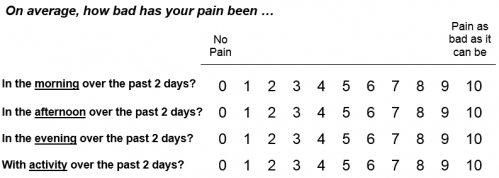4-Item Pain Intensity Measure (P4): Difference between revisions
No edit summary |
No edit summary |
||
| Line 22: | Line 22: | ||
= DN4 Questionnaire = | = DN4 Questionnaire = | ||
http://www.cheo.on.ca/uploads/1199%20DN4NeuropathicDiagnosticQuestionnaireFinal.pdf<br> | |||
= Method of Use = | = Method of Use = | ||
Revision as of 16:01, 16 November 2015
Original Editor - Evan Thomas
Top Contributors - Evan Thomas, Andeela Hafeez, WikiSysop and Melissa Coetsee
Summary[edit | edit source]
The P4 consists of 4 items that address pain intensity in the morning, afternoon, evening, and with activity over the past 2 days. Each item is scored on a 0-to-10 NPRS, therefore the total P4 scores can vary from 0 (no pain) to 40 (the highest possible pain level). Most patients can complete the P4 in less than a minute and clinicians can score the measure in 5 seconds without the use of computational aids.[1]
The purpose of developing this questionnaire was to attempt assessing change better than the two difference versions of a single-item NPRS.[1]
Intended Population[edit | edit source]
Those over the age of 16 with non-chronic musculoskeletal pain.[1] It has also been shown to be valid when used in conjunction with the WOMAC in people with osteoarthritis awaiting total knee or total hip replacements.[2]
Descripation[edit | edit source]
The DN4 (which stands for Douleur Neuropathique 4) is one of the questionnaires that can be usefu in diagnosing neuropathic pain. It has components of how the pain feels to the patient but also requires the examining health professional to assess whether there is reduced sensation (hypoaesthesia) to touch or pinprick, and whether light brushing increases or causes pain (allodynia).
This questionnaire has been well validated in a number of studies.[3]
DN4 Questionnaire[edit | edit source]
http://www.cheo.on.ca/uploads/1199%20DN4NeuropathicDiagnosticQuestionnaireFinal.pdf
Method of Use[edit | edit source]
Patients are asked to circle a single number that corresponds to their pain at each time of day and with activity over the previous 2 days. The numbers are then totaled to yield a score out of 40.
Evidence[edit | edit source]
Reliability[edit | edit source]
Test-retest reliability = 0.78[1]
it is a reliable component of the diagnostic work up for painful diabetic polyneuropathy.Cite error: Invalid <ref> tag; name cannot be a simple integer. Use a descriptive title
Validity[edit | edit source]
Longitudinal validity = 0.63 and 0.57 between the retrospective rating of change and the P4 and 24-hour NPRS (z = 1.73, P1 = .043), and 0.61 and 0.56 between the retrospective rating of change and the P4 and 2-day NPRS (z = 2.53, P1 = .006), respectively.[1]
DN4 is valid for painful diabetic polyneuropathy, which supports its usefulness as a screening tool for neuropathic pain in diabetes.Cite error: Invalid <ref> tag; name cannot be a simple integer. Use a descriptive title
Responsiveness[edit | edit source]
MDC90 = 9.1 points or 22.2% of the scale range[1]
Recent Related Research (from Pubmed)[edit | edit source]
Failed to load RSS feed from http://www.ncbi.nlm.nih.gov/entrez/eutils/erss.cgi?rss_guid=1d3MTz8-QHM_GItNR_r6Sd2JMMeJ4TF7GCftDwN62bEDZ4oE-L|charset=UTF-8|short|max=10: Error parsing XML for RSS
References[edit | edit source]
- ↑ 1.0 1.1 1.2 1.3 1.4 1.5 Spadoni GF, Stratford PW, Solomon PE, Wishart LR. The Evaluation of Change in Pain Intensity: A Comparison of the P4 and Single-Item Numeric Pain Rating Scales. J Orthop Sports Phys Ther, 2004: 34(4): 187-93.
- ↑ Stratford PW, Dogra M, Woodhouse L, Kennedy DM, Spadoni GF. Validating Self-Report Measures of Pain and Function in Patients Undergoing Hip or Knee Arthroplasty. Physiother Can, 2009: 61; 189-194.
- ↑ http://www.gloshospitals.nhs.uk/en/Wards-and-Departments/Departments/Pain-Management/Different-Pains/Nerve-Pain/Assessment-of-Nerve-Pain/DN4-Draft/







